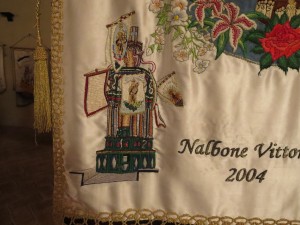
At Leonardo Scascia’s native town of Racalmuto, we visited a museum within a small castle that once served as a lookout post and warning light for a communication and defense system put in place with the allied neighboring towns. Beneath us, for example, lay a church which, never completed but still in use today, stood roofless beneath the open air. During the tour, the local guide walked us into the room where they kept all the town banners of recent years, of various kinds of depictions of the townspeople and its patroness, Mary. As he told us, the banners have a story behind them: Every year, a new banner is placed atop a wooden structure 20-30 meters tall (if I remember correctly), not unlike the miniature one depicted in the picture. A contest is held: all the eligible bachelors of the town’s families fight their way to the top, to grab the banner and claim victory and pride for their families and for themselves, since success basically means becoming a town celebrity and, in the eyes of its women, exceptionally attractive. By the way, when the guide said “fight,” he meant it: beside a ban on weapons, everything goes. In melding into one the town’s culture, tradition, religious beliefs, social and class and family and gender dynamics and identity, the contest somewhat resembles the ones held in Book V of the Aeneid, where folklore and personal and local pride come together. Too, the fact that the victory of a rare female contestant in the 80s resulted in social upheaval and the suicide of several of the losing male contestants, i.e. that men and women have clear roles in the town: reminded me of the stark separation in Book V, until the very end, of the wandering Trojan men and women and their respective (appropriate) activities.